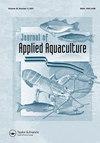鱼类饲料添加剂中的乳酸菌代谢物抑制潜在水产和食品安全致病菌生长,提高饲料转化率
IF 0.8
Q3 FISHERIES
引用次数: 1
摘要
乳酸菌发酵液(LFB)是乳酸菌生产的副产物;然而,它具有丰富的抗菌活性。这可能是一种很好的水产养殖饲料添加剂。本研究对抗菌活性最高的副干酪乳杆菌GL-156发酵液进行了安全性和肠道菌群生长性能的评价。饲料添加量为1000ppm LFB后,鲤鱼的成活率与对照组无显著差异,但生长性能显著提高。在肠道菌群分析中,处理鱼的弧菌数量减少,但细菌总数没有变化。结果表明,GL-156的LFB具有提高生长性能、抑制病原菌生长、促进益生菌生长的作用。与目前在水产养殖中使用的活菌相比,使用LFB将获得同样有益的效果,同时具有更好的制造工艺耐受性,并且成本更低。本文章由计算机程序翻译,如有差异,请以英文原文为准。
Lactic acid bacteria metabolites in fish feed additives inhibit potential aquatic and food safety pathogens growth, and improve feed conversion
ABSTRACT The fermented broth of lactic acid bacteria (LFB)was the side product while lactic acid bacteria produced; however, it was abundant of antimicrobial activity. That might be a good candidate for feed additive in aquaculture. In this study, the fermented broth of Lactobacillus paracasei GL-156, the most antibacterial activity, was further evaluated the safety, growth performance gut microbiota. Common carp consumed the feed in dose of 1000 ppm LFB, the survival was no significant different with control group, but the growth performance was significant increased. In the intestine microbiota analysis, the treatment fish shown the decrease of vibrio, but no different of total bacterial count. These results demonstrate the LFB from GL-156 in enhancing the growth performance, inhibiting the growth of pathogenic bacteria, and promoting the growth of probiotic organisms. Compare with live probiotics currently used in aquaculture, using LFB will achieved beneficial effects equally, while providing superior tolerance to manufacturing processes, and in the lower cost.
求助全文
通过发布文献求助,成功后即可免费获取论文全文。
去求助
来源期刊

Journal of Applied Aquaculture
Environmental Science-Ecology
CiteScore
3.20
自引率
0.00%
发文量
38
期刊介绍:
The Journal of Applied Aquaculture is a platform for the sharing of practical information needed by researchers to meet the needs of investors, farm managers, extension agents and policy makers working to adapt aquaculture theory to achieve economic and food security objectives in the real world. The journal emphasizes multi-disciplinary research and case studies that propose financially and logistically viable solutions to observable problems.
 求助内容:
求助内容: 应助结果提醒方式:
应助结果提醒方式:


